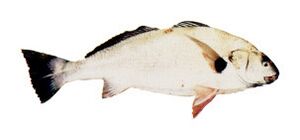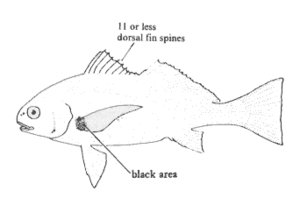Spotfin croaker facts for kids
Quick facts for kids Spotfin croaker |
|
|---|---|
 |
|
| Conservation status | |
| Scientific classification | |
| Synonyms | |
|
The spotfin croaker (Roncador stearnsii) is a type of ray-finned fish that lives in the ocean. It belongs to the family called Sciaenidae, which includes many "drum" and "croaker" fish. This fish is found along the coast from Mazatlán, Mexico, up to Point Conception, California. It also lives in the Gulf of California.
The spotfin croaker is the only species in its group, called Roncador. In California, you'll most often find them south of Los Angeles Harbor. They live near beaches and in bays. They like areas with coarse sand or heavy mud. You can find them in water from 4 to 50 feet deep, often hiding in dips and holes close to shore.
Contents
What Does a Spotfin Croaker Look Like?
The spotfin croaker has a long body that is thicker near its head. Its head slopes steeply and is slightly curved. The front of its snout is very blunt and rounded. Its mouth is located underneath its head, which is called a subterminal mouth.
These fish are silvery-gray with a bluish shine on top. Their underside is white. They have dark, wavy lines along their sides. A special mark is a large black spot at the base of their pectoral fin. This spot helps tell them apart from other fish.
How to Tell Spotfin Croakers Apart
The spotfin croaker's mouth is under its head, and it doesn't have a fleshy barbel (a whisker-like growth). The big black spot on its pectoral fin is a clear sign. These features help tell them apart from other "croaker" fish in California.
Sometimes, small spotfin croakers might look like small white croakers. But you can count the spines on their dorsal fin to tell them apart. Spotfin croakers usually have 11 or fewer spines, often 10. White croakers have 12 to 15 spines. Large male spotfin croakers can turn a brassy color during breeding season. People used to call these "golden croakers," thinking they were a different species.
Spotfin Croaker Diet and Reproduction
Spotfin croakers eat many different things. They enjoy clams and worms. They also eat a lot of small crustaceans, like tiny crabs or shrimp. They have strong, flat teeth in their throat, called pharyngeal teeth, which they use to crush their food.
Life Cycle and Spawning
Male spotfin croakers are ready to spawn (reproduce) when they are two years old and about 9 inches (23 cm) long. Most females mature when they are three years old and about 12.5 inches (32 cm) long. By the time they are four years old and 14.5 inches (37 cm) long, all females are ready to reproduce.
The spawning season for spotfin croakers is from June to September. It's thought that they lay their eggs offshore, away from the immediate coast. This is because no adult fish ready to spawn have been caught near the shore. Very young spotfin croakers, about 1 inch (2.5 cm) long, start appearing in the surf in the fall.
Where Do They Travel?
Spotfin croakers move around a lot, but they don't follow a clear path. They often travel between different bays. For example, fish that were tagged in Los Angeles Harbor were later found as far south as Oceanside. Spotfin croakers tagged in Newport Bay were found in Alamitos Bay, and vice versa.
Fishing for Spotfin Croakers
You can catch spotfin croakers throughout the year, but the best time for fishing is usually late summer. Good fishing often depends on finding a "croaker hole" where many fish gather. When you find one, you can have great success, whether you're fishing in a bay, from a pier, or in the ocean surf. Most spotfin croakers caught are small to medium-sized. The biggest one ever recorded was 27 inches long and weighed 10.5 pounds.
Historically, spotfin croakers were very popular for fishing in Southern California. A hundred years ago, there were so many of them that many pier and surf fishermen paid close attention to them. They provided exciting action when they gathered in groups along beaches or near piers. Places like Santa Monica, Mission Bay, Imperial Beach, San Onofre, and Newport Bay were once famous for their croaker fishing.
Spotfin croakers like to eat clams, mussels, and worms.



